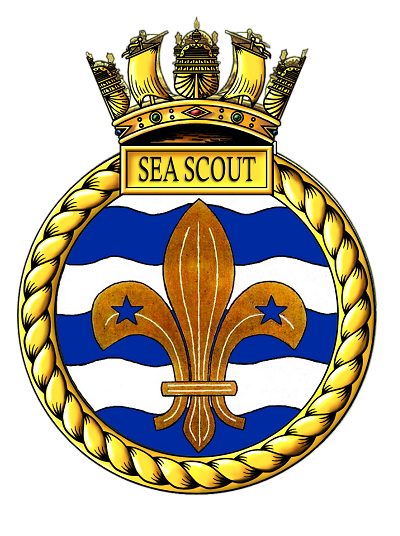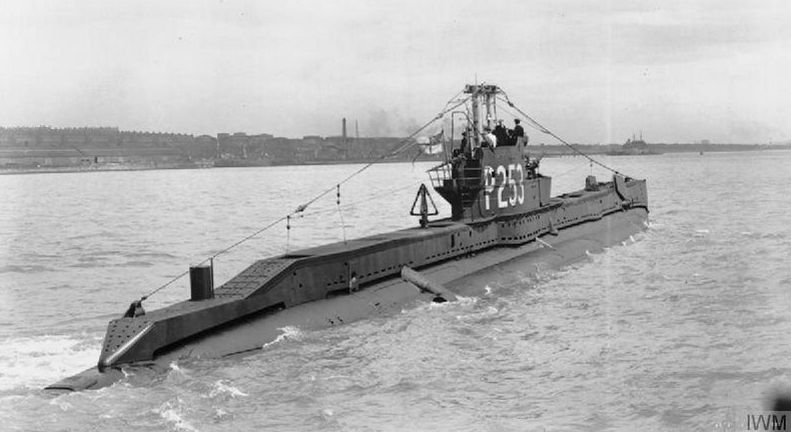S-Class Submarine

Battle Honours
Atlantic 1944
Malaya 1945
Specifications
Builder: Cammell Laird Shipyard, Birkenhead, United Kingdom
Displacement: 814 tons
Length: 217 ft
Beam: 23 ft 8 in
Draught: 11 ft
Propulsion: 2 × 950 bhp (708 kW) diesel engines, 2 × 650 hp (485 kW) electric motors driving two propellers
Speed: 14.75 knots (16.97 mph; 27.32 km/h) surfaced. 9 knots (10 mph; 17 km/h) submerged
Range: 7,500 Nautical miles surfaced (8,600 mi; 13,900 km) at 10 knots (12 mph; 19 km/h) 120 Nautical miles submerged ( 140 mi; 220 km) at 3 knots (3.5 mph; 5.6 km/h)
Armament: 6 × bow & 1 stern 21 in (533 mm) torpedo tubes – carried 13 torpedoes or 12 mines; 1 × three-inch (76 mm) gun (QF 4-inch deck gun; 1 × 20 mm Oerlikon AA gun; 3 × .303 calibre machine guns
Crew complement: 48
Commanding Officers
Lt. James William Kelly, RN 15 Apr 1944 - 05 Dec 1945
Lt. Cdr D.C.R. Walters, Mar 1951
Lt. Cdr P.J. Holloway, Aug 1953
Lt. A.J Whetstone, Oct 1955
Lt. R.J.F. Heath, Aug 1957
Lt. B.C. Robertson, Nov 1959
Lt. Cdr G.R.H. Lloyd-Williams, Mar 1961
Related items
None
Reminiscences
None
Gallery
None
H.M. S/M SEA SCOUT
PAGE UNDER CONSTRUCTION
Read aloud

Image copyright IWM (FL 18888)
History
She was ordered from Cammell Laird Shipyard, Birkenhead on October 10th 1942, one of the batch four boats ordered as part of the third group of S class submarines for the Royal Navy. Her keel was laid down on Apr 1st 1943. She was launched on March 24th 1944.
On completion of her builder’s trials She departed for Holy Loch on June 17th to begin a period of trials and training, arriving three the later the same day. She commissioned at Holy Loch as H.M. Submarine SEA SCOUT on June 19th 1945 under the command of Lieutenant J. W. Kelly, RN.
At Holy Loch she conducted Torpedo, Gunnery, Bombardment, D/F and RDF exercises and performed simulated day and night attacks, both submerged and surface actions. She also performed trials at the torpedo firing range at Arrochar. Local vessels acted as targets. On June 29th she conducted day and night attack exercises in the Clyde area with sister Boat H.M. Submarine SHALIMAR during which they made attacks on each other.
On completion of her final training exercise at Holy Loch SEA SCOUT departed Holy Loch for Scapa Flow on July 14th escorted by the destroyer HMS SARDONYX, arriving the 16th. At Scapa she conducted A/S exercises before sailing for Holy Loch in company with SARDONYX on the 30th. She arrived back at Holy Loch on August 1st to resume training.
On August 3rd she conducted day and night attack exercises in the Clyde area with sister Boat H.M. Submarine SHAKESPEARE during which they made attacks on each other. SEA SCOUT sailed from Holy Loch on September 5th for Lerwick in company with her sister boat SCYTHIAN (bound for Scapa Flow) escorted by the armed yacht HMS CUTTY SARK. She arrived there on the 7th and sailed later the same day on her first, work-up, war patrol with orders to patrol in the North Sea to the East of the Orkney Islands. She ended her first war patrol at Lerwick on September 19th. She sailed for Holy Loch on the 23rd, in company with sister S Class boat SCEPTRE arriving on the 276th.
Allocated to the Eastern Fleet
H.M. Submarine SEA SCOUT sailed from Rothesay on October 15th for passage to Gibraltar on the first leg of voyage to the Far East. She is in company with the T Class boats TRIDENT and THRASHER and all three sail with the joint convoy OS.92 / KMS.66 for passage; the convoy split late on the 25th off Gibraltar and the three submachine's arrived at Gibraltar on the 26th. They sailed for Malta on the 28th arriving on November 3rd. They were to spend a week here before continuing on to Port Said arriving on the 14th. SEA SCOUT now continued on alone, transiting the Suez Canal on the 15th arriving at Aden on the 21st. She departed for Colombo on the 24th, arriving on December 4th and continuing on to Trincomalee the following day. At Trincomalee she entered a drydock for maintenance before sailing for her 2nd war patrol (1st in the Far East) on Christmas Eve 1844 with orders to patrol in the Andaman Sea and off Northern Sumatra.
She was to make two more war patrols in the Indian Ocean before switching to the Southwest Pacific.
Reallocated to the British Pacific Fleet
In March 1945 SEA SCOUT was allocated for service in the Pacific, she sailed from Colombo on March 31st for her 4th war patrol (3rd in the Far East and 1st in the South-West Pacific area) operating in the Bali and Flores Seas. She ended her 4th war patrol at Fremantle, Australia on May 4th; she now came under operational control of the US 7th Fleet Task Force 71 for operations in the Pacific. After making repairs, including a spell in drydock, SEA SCOUT departed Fremantle for Subic Bay, Philippines on May 26th. She arrived at Subic Bay on June 11th where she was attached to the Submarine Depot Ship MAIDSTONE.
She was to sail for two further war patrols before the Japanese surrendered on August 15th; the first, on June 16th, as part of a Wolf Pac patrolling in the Gulf of Siam operating with H.M. Submarines SELENE, SUPREME the U.S. submarines CHARR and LAMPREY. Her 6th and final patrol was again in the Gulf of Siam, sailing on August 8th and ending at Subic Bay on August 20th.
Post War history
Soon after the end of hostilities operational control of the 8th Submarine Flotilla was returned to the RN which was now reallocating forces for the reoccupation of former British colonies and humanitarian aid. HMS MAIDSTONE and the boats of the 8th Submarine Flotilla departed Subic Bay for Hong Kong on August 27th, Joining Task Group 111.2 for the re-occupation of the colony. The force arrived at the colony on August 30th, MAIDSTONE and her charges remained at sea until the harbour was declared safe. The crews of the RN submarines in Hong Kong assisted with repairing the colonies power and water supplies as well as providing men towards shore patrols and personnel for guard duties.
SEA SCOUT departed Hong Kong to return to the U.K on September 11th; she arrived at Trincomalee on the 24th and received repairs before sailing on the 30th. She arrived at Portsmouth on November 10th 194. H.M. Submarine SEA SCOUT was placed in reserve on December 5th 1945.
After the war the surviving S Class boats were refitted to install a folding snorkel mast aft of the control tower; to accommodate this the stern torpedo tube and the 'Bandstand' Anti-Aircraft platform and 20mm Oerlikon were removed. Some had their main deck gun removed as well. The snorkel allowed a submarine to cruise on diesel engines while submerged allowing the batteries to be recharged without the need to surface and risk detection by an enemy. When raised the ‘snort’ was the only part of the boat above the surface drawing in clean air while discharging the toxic diesel exhaust. Later modernisation work included installation of an improved sonar mounted in a dome on the casing above the forward dive plane and improved radar.
SEA SCOUT appears to have been briefly allocated to the 2nd Submarine Flotilla, attached to HMS MAIDSTONE, at Portland in 1947 but there is no information about a commanding officer being appointed. It is assumed she underwent her modification refit upon release from the 2nd Submarine Flotilla.
Lieutenant Commander D.C.R. Walters, was appointed as the commanding officer of SEA SCOUT in March 1951; she joined the 3rd Submarine Flotilla attached to HMS WOLFE at Rothesay in 1952. She was reallocated to the5th Submarine Flotilla, HMS Dolphin, Gosport in 1953. In June of that year she was one of 26 submarines that took part in the Fleet Review to celebrate the Coronation of Queen Elizabeth II. Her third commanding officer, Lieutenant Commander P.J. Holloway, RN arrived in August 1953, and her fourth, Lieutenant A.J Whetstone, RN in October 1955.
In 1957 SEA SCOUT was reallocated to the 2nd Submarine Squadron, attached to the depot ship HMS Tyne, at Portland, receiving her fifth commanding officer, Lieutenant R.J.F. Heath, Rn in August 1957.
She was to spend her last years in RN service with the 5th Submarine Squadron at HMS Dolphin, Gosport where she arrived in 1959. Lieutenant B.C. Robertson, RN was appointed as commanding officer in November 1959, he was relieved by Lieutenant Commander G.R.H. Lloyd-Williams, RN in March 1961.
SEA SCOUT lefty the squadron in 1962 and placed in reserve pending disposal. She was eventually sold and arrived at Swansea for breaking up on December 14th 1965.
Last modified: 23 February 2023
Primary information sources
Additional sources:
uboat.net entry for H.M. Submarine SEA SCOUT
British Pacific Fleet, Admiralty Diary - Occupation of China Coast 1945
Comments (0)